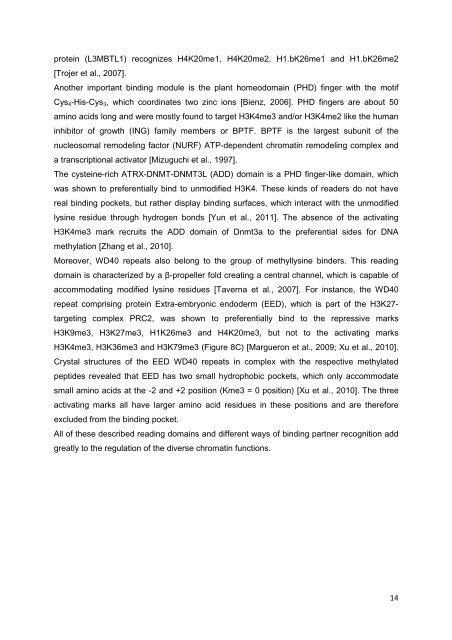PhD Thesis of Ina Bock - digital version - Jacobs University
PhD Thesis of Ina Bock - digital version - Jacobs University
PhD Thesis of Ina Bock - digital version - Jacobs University
You also want an ePaper? Increase the reach of your titles
YUMPU automatically turns print PDFs into web optimized ePapers that Google loves.
protein (L3MBTL1) recognizes H4K20me1, H4K20me2, H1.bK26me1 and H1.bK26me2<br />
[Trojer et al., 2007].<br />
Another important binding module is the plant homeodomain (PHD) finger with the motif<br />
Cys 4 -His-Cys 3 , which coordinates two zinc ions [Bienz, 2006]. PHD fingers are about 50<br />
amino acids long and were mostly found to target H3K4me3 and/or H3K4me2 like the human<br />
inhibitor <strong>of</strong> growth (ING) family members or BPTF. BPTF is the largest subunit <strong>of</strong> the<br />
nucleosomal remodeling factor (NURF) ATP-dependent chromatin remodeling complex and<br />
a transcriptional activator [Mizuguchi et al., 1997].<br />
The cysteine-rich ATRX-DNMT-DNMT3L (ADD) domain is a PHD finger-like domain, which<br />
was shown to preferentially bind to unmodified H3K4. These kinds <strong>of</strong> readers do not have<br />
real binding pockets, but rather display binding surfaces, which interact with the unmodified<br />
lysine residue through hydrogen bonds [Yun et al., 2011]. The absence <strong>of</strong> the activating<br />
H3K4me3 mark recruits the ADD domain <strong>of</strong> Dnmt3a to the preferential sides for DNA<br />
methylation [Zhang et al., 2010].<br />
Moreover, WD40 repeats also belong to the group <strong>of</strong> methyllysine binders. This reading<br />
domain is characterized by a β-propeller fold creating a central channel, which is capable <strong>of</strong><br />
accommodating modified lysine residues [Taverna et al., 2007]. For instance, the WD40<br />
repeat comprising protein Extra-embryonic endoderm (EED), which is part <strong>of</strong> the H3K27-<br />
targeting complex PRC2, was shown to preferentially bind to the repressive marks<br />
H3K9me3, H3K27me3, H1K26me3 and H4K20me3, but not to the activating marks<br />
H3K4me3, H3K36me3 and H3K79me3 (Figure 8C) [Margueron et al., 2009; Xu et al., 2010].<br />
Crystal structures <strong>of</strong> the EED WD40 repeats in complex with the respective methylated<br />
peptides revealed that EED has two small hydrophobic pockets, which only accommodate<br />
small amino acids at the -2 and +2 position (Kme3 = 0 position) [Xu et al., 2010]. The three<br />
activating marks all have larger amino acid residues in these positions and are therefore<br />
excluded from the binding pocket.<br />
All <strong>of</strong> these described reading domains and different ways <strong>of</strong> binding partner recognition add<br />
greatly to the regulation <strong>of</strong> the diverse chromatin functions.<br />
14
















